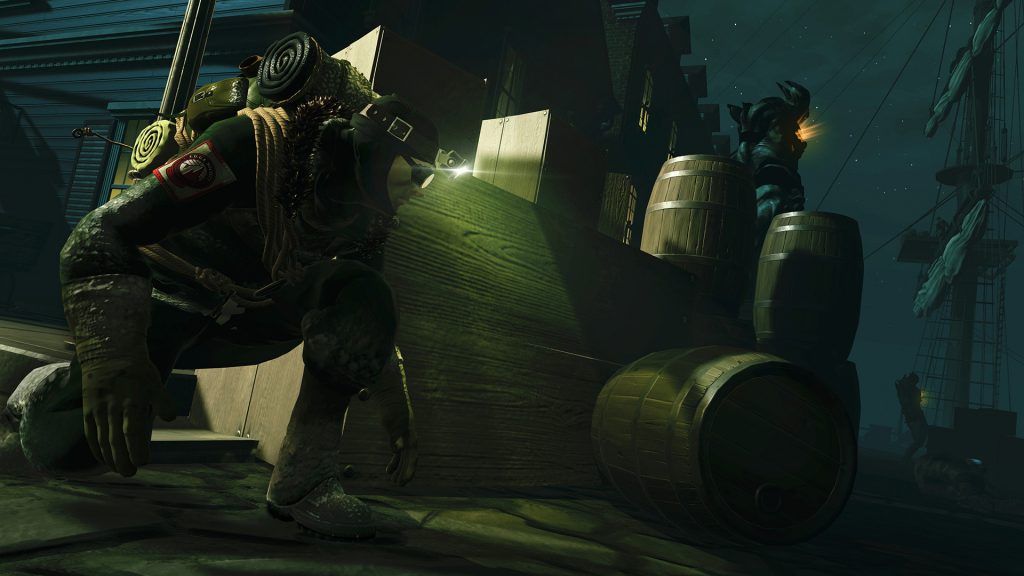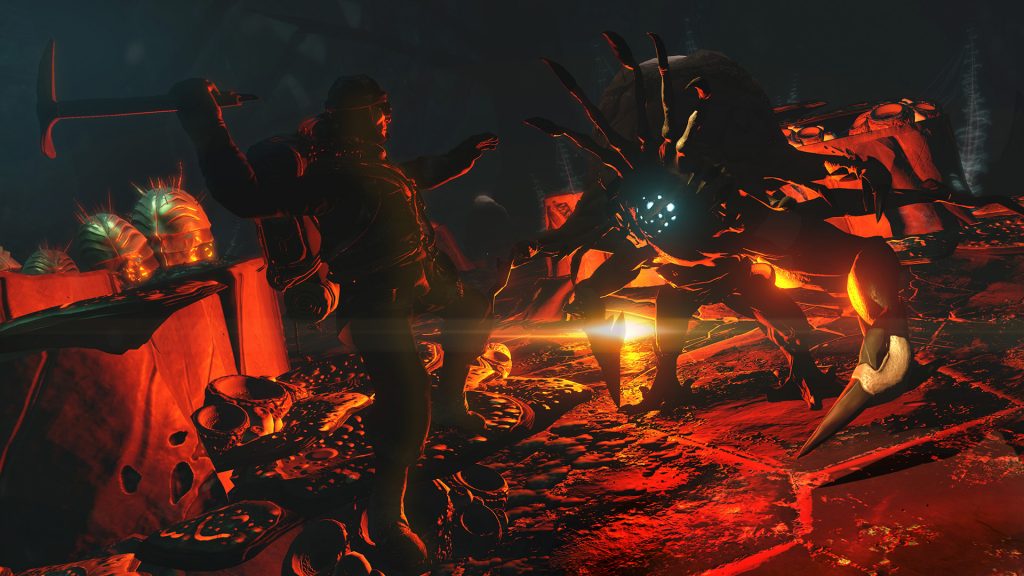Following in the footsteps of a lost Antarctic expedition, Victor Howard is a man on a mission to rescue his missing fiancee. What would ordinarily be a straightforward Tomb Raider/Uncharted style adventure is livened up by a Lovecraftian theme, climbing precarious outcrops and unloading shotguns broken up by eldritch abominations and vivid hallucinations. It’s a promising mix – psychological Cthulhu horror and virtual reality are exactly the kind of terrifying bedfellows that make for a good time. It’s a tale as old as time – boy meets girl, girl meets tentacles, you know where this is going. Yet, except for a few choice moments, VR doesn’t really add anything to the game.
Witnessing the hallucinations first hand, reality flickering in and out around you as whispers come from all angles and shadows – all things that should have been zeroed in on, but they play second fiddle to some bog standard rock-climbing and half-cocked stealth action. When Edge of Nowhere uses VR’s strengths, it does so very well, but those moments are fleeting. Had it been a standard console release, the adventuring elements would have been decimated by comparisons to Nathan Drake and Lara Croft, and the horror tones would have been downright forgettable, parroted a million times before through books, movies and other games (it would also have been lambasted for a paltry length).

On higher levels stealth becomes essential and your shotgun is a last resort, but many of the sneaking sections can be brute-forced because Victor runs faster than most of your enemies.
Most of your time will be spent crawling through caves, using the environment and stealth to take out ancient alien horrors, and these are probably the most competent parts of the game. It uses light and shadow brilliantly to build tension and start layering in the story via a gallery of flashbacks. Squeezing past blind monstrosities that dive onto the nearest noise with quivering mandibles and blades outstretched, a finger hovering over your shotgun just in case things go south, sprinting through collapsing tunnels with the clicking menace at your heels – it all really benefits from the directional capacities of your headset. Even wandering the frozen wastes is great at times, suffocating in its vastness, but when you need to climb a series of collapsing ice walls again to get from A to B cracks start to show.
Edge detection in the platforming segments isn’t up to the high standard of the genre’s two big players, and often Victor will fall to his death because you landed with a single toe on a ledge you were supposed to catch, resulting in replaying the entire section up to that point. Climbing just isn’t that fun, and the sense of scale it strives to build falls flat when you look down and just see cold blue emptiness. Compared to the dizzying heights you reach in The Climb, it’s underwhelming, and I’ve felt more vertigo hanging off of trains in Uncharted 2 eight years ago.
Edge of Nowhere blurs the line between reality and madness very well. Hallucinations are woven into the levels themselves, the world around you slowly shifting from forbidden cave to lonely households, lecturing halls and deep jungles. It’s worth playing for those moments alone, they leave you questioning the events that lead you to the expedition, and whether or not Victor was even sane to begin with. It just gets bogged down with mediocrity inbetween, falling seriously short especially when you look at The Unspoken, Insomniac‘s other VR offering. It does make a solid argument towards the value of developing third person games on the platform, adding incredible immersion to its set pieces, but the climbing mechanics scuttle all of that on a regular basis.

Most enemies are blind and easily manipulated by chucking rocks, allowing you to avoid direct confrontations entirely. There are a couple of occasions where the game ladens you with ammo to shoot your way out, and it’s super satisfying.
It’s a solid game on many basic levels, but certainly not up to the true potential of VR, Lovecraft, or even Insomniac‘s legendary development ability. Edge of Nowhere was obviously a cautious first step onto a new front, brief and simple with some flashes of genius throughout, and hopefully it’s given them some great insight on how to do more in future. Coming face to face with Cthulhu and the depths of mortal madness is impressive but fleeting, held back by uninspired rock-lobbing and wall-scrabbling that staggers the inspired reality shifts to a snail’s pace. I enjoyed my time with it, but I’m not going back – not out of primal fear, but simply because I saw all it had to offer the first time around. Sure, I could play it on the hardest difficulty for some extra-stressful spelunking, but the real enemy is crippling edge detection and linearity, and they’re much more detrimental to Victor’s doomed journey than any tentacled ancient one ever is.
THE TL;DR:
- VR enters Uncharted territory with this third person psychological adventure, cleverly using interactive flashbacks to tell a story.
- The gameplay itself leaves a lot to be desired with sticky melee combat and wonky climbing.
- It’s all stuff we’ve seen before, playing it fairly safe with the Lovecraft material, but makes for an interesting diversion.
- Wait for it to go on sale – at full price you can pick up some much more involved VR experiences instead.
67%
You can click here to read more of our games reviews.